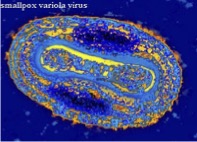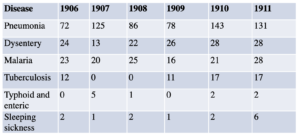Now that we are suffering another epidemic, it is interesting to look at the epidemics in Nairobi 120 years ago, when the city was in its infancy. There was an outbreak of bubonic plague in 1902, in the Indian bazaar. There were 69 cases of whom 55 died. Energetic measures were taken to combat the plague, with the Indian bazaar being burnt down and its occupants being removed to a quarantine camp. The epidemic was finally stamped out and the government was left to bear a heavy bill for compensation and other costs. Altogether this amounted to £23,000. A second outbreak took place in 1905, but this was less serious, and was confined to an African living in the Indian bazaar, another living in the railway landings, another in Mombasa village (which was within Nairobi), an Indian living in the Indian bazaar, and three Nubians living in Police lines. Four deaths were recorded. Bubonic plague is caused by the bacterium Yersinia pestis, which struck again, the following year, in 1906.
This outbreak began on 2 February 1906 and lasted until 11 May 1906, practically the length of the ‘long rains.’This time 15 Africans were infected and 14 died; of the 9 infested Indians 6 died, and one Goan died. The cases took place in the Indian bazaar, Nairobi’s African villages, the slaughterhouse, railway quarters and European houses in the suburbs. Plague infected rats were found in every part of the town, though not in large numbers.
Plague then disappeared for a few years, but it was replaced by a smallpox epidemic, breaking out on 9 April 1909 and lasting until July. There were 245 cases and 67 deaths. These were all Africans, because of the 6 European and 11 Asiatic cases none died. The first known case occurred near the slaughterhouse and it spread to Duke Street, Victoria Street and the railway quarters. The Indian bazaar was not involved and was untouched. To combat the epidemic 8,000 people were vaccinated, some huts were burned, house to house inspections took place and infected clothing was destroyed. At least the death rate was not as high as with bubonic plague.

It would have been foolish to assume that bubonic plague had been eradicated, because there was yet another outbreak in 1911, beginning on 14 May and lasting until 16 September 1911. The first case occurred in a back street of the Indian bazaar and there were in all 39 cases, of whom 22 died. Of these, 3 were Goans (all died), 12 were Asiatics (7 deaths), and 24 were Africans (14 deaths). The area of distribution was: Indian bazaar (16), Victoria Street (5), Swamp (5), River Road (4), Government Road (6), Police lines (2), Racecourse Road (2), and Duke Street (1).
Systematic fumigation and disinfection of infected houses and clothing was carried out, while 6,140 persons were inoculated with plague vaccine and a large number of rats were either found dead or killed. A plague camp was formed, to which patients were transferred and kept in strict quarantine. Dead and diseased rats were found in the Jeevanjee market and half of this was temporarily closed and thoroughly disinfected and repaired. Stringent quarantine restrictions were imposed. The Medical Officer of Health believed plague to be endemic in Nairobi and likely to recur regularly. This happened sporadically until the invention of antibiotics.
To put the plague deaths in a wider context, let us look at the causes of death for a few years in Nairobi:



Recent Comments